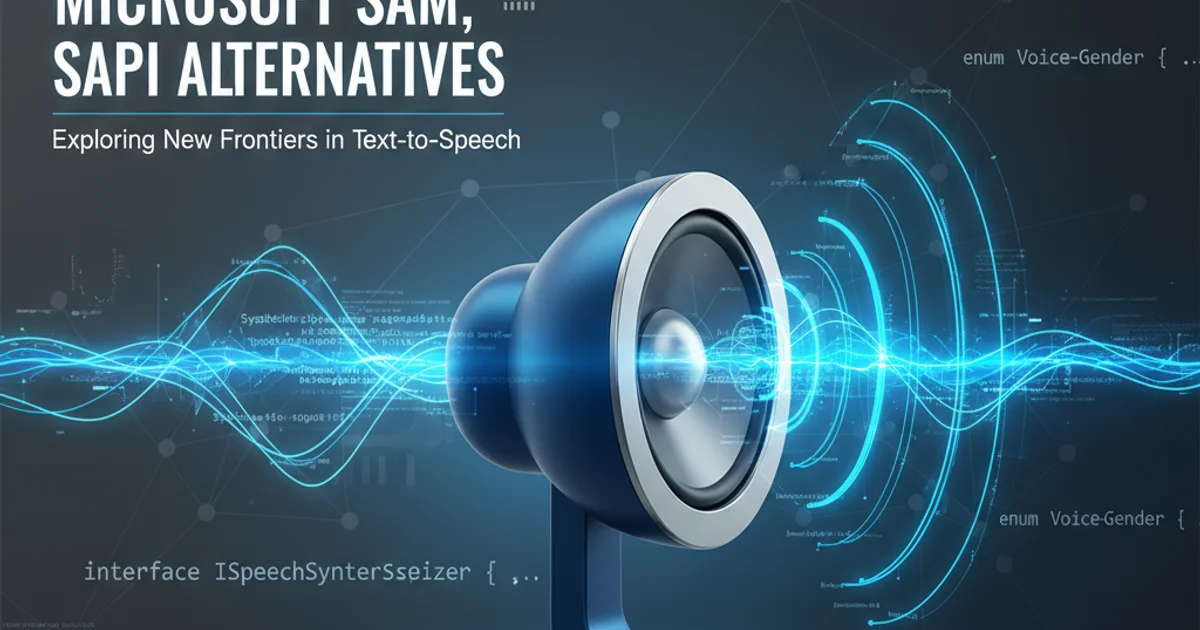Microsoft Sam, SAPI alternatives
Categories:
Beyond Microsoft Sam: Exploring SAPI Alternatives for Text-to-Speech in C#

Dive into the world of Text-to-Speech (TTS) in C#, moving past the classic Microsoft Sam to leverage modern SAPI voices and explore advanced alternatives for richer, more natural speech synthesis.
For many Windows users, the name "Microsoft Sam" evokes a nostalgic, if somewhat robotic, memory of early text-to-speech (TTS) capabilities. While Sam served its purpose, modern applications demand more sophisticated and natural-sounding voices. This article explores how to move beyond the basics, utilizing the Speech Application Programming Interface (SAPI) in C# to access a wider range of voices, and then delves into more advanced alternatives for high-quality, cloud-based speech synthesis.
Understanding SAPI and Its Evolution
The Speech Application Programming Interface (SAPI) is Microsoft's framework for speech recognition and text-to-speech functionalities within Windows. It provides a standardized way for applications to interact with speech engines. While older versions of Windows might have defaulted to simpler voices like Microsoft Sam, modern Windows installations (Windows 7 and later) come with significantly improved, more natural-sounding voices (e.g., Microsoft Zira, David, Hazel for English). SAPI allows you to enumerate these installed voices and select the one best suited for your application.
flowchart TD
A[Application] --> B{"SAPI (System.Speech)"}
B --> C{Installed TTS Engines}
C --> D["Microsoft Zira/David/Hazel"]
C --> E["Third-Party SAPI Voices"]
D --> F["Synthesized Audio Output"]
E --> FHow SAPI interacts with installed Text-to-Speech engines.
Implementing SAPI Text-to-Speech in C#
Working with SAPI in C# is straightforward, primarily using the System.Speech.Synthesis namespace. This namespace provides classes like SpeechSynthesizer to manage voice selection, speech rate, volume, and the actual synthesis process. The following code demonstrates how to list available voices and then use a selected voice to speak a phrase.
using System;
using System.Speech.Synthesis;
public class SapiTTS
{
public static void Main(string[] args)
{
using (SpeechSynthesizer synth = new SpeechSynthesizer())
{
// Configure the audio output
synth.SetOutputToDefaultAudioDevice();
Console.WriteLine("Available Voices:");
foreach (InstalledVoice voice in synth.GetInstalledVoices())
{
VoiceInfo info = voice.VoiceInfo;
Console.WriteLine($" Name: {info.Name}, Gender: {info.Gender}, Age: {info.Age}, Culture: {info.Culture}");
}
// Select a specific voice (e.g., 'Microsoft Zira Desktop')
// You might need to adjust this based on installed voices on your system
try
{
synth.SelectVoice("Microsoft Zira Desktop");
Console.WriteLine("\nSpeaking with Microsoft Zira Desktop:");
synth.Speak("Hello, this is a demonstration of modern SAPI voices.");
}
catch (ArgumentException)
{
Console.WriteLine("\nMicrosoft Zira Desktop voice not found. Using default voice.");
synth.Speak("Hello, this is a demonstration using the default SAPI voice.");
}
Console.WriteLine("\nPress any key to exit.");
Console.ReadKey();
}
}
}
C# code to list SAPI voices and perform text-to-speech.
SpeechSynthesizer instance in a using statement to ensure proper disposal of resources, especially audio devices.Advanced Alternatives: Cloud-Based TTS Services
While SAPI offers good local TTS capabilities, for the highest quality, most natural-sounding voices, and a wider range of languages and customization options, cloud-based TTS services are often the superior choice. Services like Google Cloud Text-to-Speech, Amazon Polly, and Microsoft Azure Cognitive Services provide advanced neural voices that are virtually indistinguishable from human speech. These services typically involve making API calls to their respective platforms, which then return synthesized audio.
sequenceDiagram
participant App as C# Application
participant CloudTTS as Cloud TTS Service (e.g., Azure, AWS, Google)
App->>CloudTTS: Send Text for Synthesis
CloudTTS-->>App: Return Synthesized Audio (MP3/WAV)
App->>App: Play AudioSequence diagram for cloud-based Text-to-Speech.
Example: Using Azure Cognitive Services for TTS
Microsoft Azure Cognitive Services offers a robust Text-to-Speech API with a vast selection of neural voices. To use it, you'll need an Azure subscription, a Cognitive Services resource, and an API key. The process generally involves installing the Azure SDK for C# and then making a call to the service.
using System;
using System.Threading.Tasks;
using Microsoft.CognitiveServices.Speech;
using Microsoft.CognitiveServices.Speech.Audio;
public class AzureTTS
{
public static async Task Main(string[] args)
{
// Replace with your actual subscription key and region
string speechKey = "YOUR_SPEECH_KEY";
string speechRegion = "YOUR_SPEECH_REGION";
if (speechKey == "YOUR_SPEECH_KEY" || speechRegion == "YOUR_SPEECH_REGION")
{
Console.WriteLine("Please set your Azure Speech subscription key and region in the code.");
Console.WriteLine("You can get a free trial key from: https://azure.microsoft.com/en-us/services/cognitive-services/speech-services/");
return;
}
var speechConfig = SpeechConfig.FromSubscription(speechKey, speechRegion);
// Select a neural voice (e.g., 'en-US-JennyNeural')
speechConfig.SpeechSynthesisVoiceName = "en-US-JennyNeural";
using (var synthesizer = new SpeechSynthesizer(speechConfig, AudioConfig.FromDefaultSpeakerOutput()))
{
Console.WriteLine($"Speaking with Azure Neural Voice: {speechConfig.SpeechSynthesisVoiceName}");
Console.WriteLine("Enter text to speak, or 'exit' to quit:");
while (true)
{
Console.Write("> ");
string text = Console.ReadLine();
if (text.ToLower() == "exit")
{
break;
}
if (!string.IsNullOrWhiteSpace(text))
{
var result = await synthesizer.SpeakTextAsync(text);
if (result.Reason == ResultReason.SynthesizingAudioCompleted)
{
Console.WriteLine($"Speech synthesized for text: \"{text}\"");
}
else if (result.Reason == ResultReason.Canceled)
{
var cancellation = SpeechSynthesisCancellationDetails.FromResult(result);
Console.WriteLine($"CANCELED: Reason={cancellation.Reason}");
if (cancellation.Reason == CancellationReason.Error)
{
Console.WriteLine($"CANCELED: ErrorCode={cancellation.ErrorCode}");
Console.WriteLine($"CANCELED: ErrorDetails={cancellation.ErrorDetails}");
Console.WriteLine($"CANCELED: Did you set the speech key and region?");
}
}
}
}
}
Console.WriteLine("Exiting application.");
}
}
C# code demonstrating text-to-speech using Azure Cognitive Services.
Choosing between local SAPI voices and cloud-based services depends on your application's requirements. For simple, offline applications, SAPI is a perfectly viable and free solution. For applications requiring the highest fidelity, a wide range of languages, or dynamic voice customization, cloud services offer unparalleled quality and flexibility.